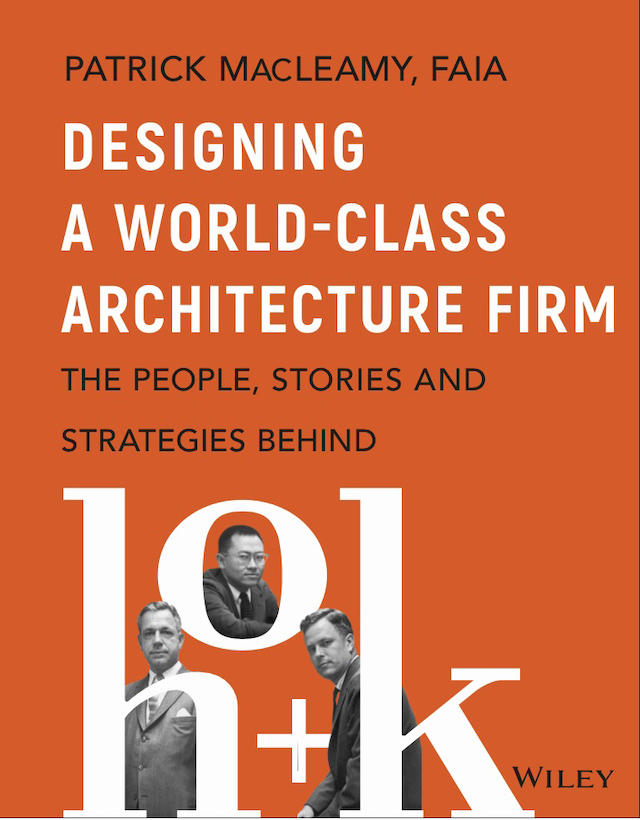Designing a World-Class Architecture Firm
Designing a World-Class Architecture Firm: The People, Stories, and Strategies Behind HOKPatrick MacLeamyWiley, April 2020Hardcover | 7-1/4 x 9-1/4 inches | 288 pages | English | ISBN: 978-1119685302 | $75.00PUBLISHER'S DESCRIPTION: Designing a World Class Architecture Firm: The People, Stories and Strategies Behind HOK tells the history of one of the largest design firms in the world and draws lessons from it that can help other architects, interior designers, urban planners and creative services professionals grow bigger or better. Former HOK CEO Patrick MacLeamy shares the revolutionary strategies HOK’s founders deployed to create a brand-new type of architecture firm. He pulls no punches, revealing the triple crisis that almost bankrupted HOK and describes how any firm can survive and thrive. Designing a World Class Architecture Firm tells the inside story of many of HOK’s most iconic buildings, including the National Air and Space Museum, Moscone Convention Center, Oriole Park at Camden Yards, the Houston Galleria and the reimagined LaGuardia Airport. Each chapter conveys lessons learned from HOK’s successes —and failures— including: The importance of diversifying to depression-and-recession-proof your firm The benefit of organizing your firm around specialized leaders and project types The difference between leading and managing your people The value of simple financial metrics to ensure your firm’s health and profitability The “run toward trouble” strategy which prevents problems from ballooning MacLeamy delivers his advice via inspirational stories such as how HOK survived when its home office in St. Louis went up in flames and humorous stories, like the time an HOK executive was mistaken for royalty on a trip to Saudi Arabia. In this tell-all guide, the driven architecture or design professional will find the tools needed to evolve or grow any firm. Patrick MacLeamy, FAIA, worked his way up from junior designer to CEO of HOK, a global architecture, engineering, and planning firm, where he worked for 50 years. A self-taught executive, MacLeamy loved designing a firm just as much as he loved designing buildings. He is best known in the design and construction industry as the creator of the "MacLeamy Curve," which advocates front-loading effort during the design process to catch errors early. A pioneer in leveraging technology to support design quality, MacLeamy is chairman of buildingSMART International (bSI) where he pushes tirelessly for the global implementation of building information modeling (BIM). REFERRAL LINKS: dDAB COMMENTARY: In a roundup of a dozen architecture books at the end of 1984, New York Times architecture critic Paul Goldberger describes Architecture in the Real World: The Work of HOK by Walter McQuade as "a strained homage to a huge architecture firm — the St. Louis-based Hellmuth, Obata and Kassabaum (HOK) — noted more for its marketing skill than its buildings." The perception of HOK buildings in a less than flattering light, design-wise, can also be found in Architect magazine's "Architect 50" list, most recently done in 2019. HOK checks in at #39 overall, with a score of 83 (the #1 firm sets the baseline of 100), a respectable showing on a list that, instead of being focused just on billings, ranks US firms according to three criteria: design, sustainability, and business. Yet, while HOK is #10 on the sustainability list and #32 for business, it's way down at #118 relative to design. When focused squarely on revenue, though, as in Architectural Record's annual list, HOK fares much better, coming it at #6 in 2019. The above comments are to say that when it comes to books related to HOK, the most valuable ones would not be monographs about their buildings, they would be books focused on the business side of the firm. The ideal HOK book would offer lessons in management and other aspects of running an architecture firm; and perhaps some advice on sustainable design, given their high marks in the Architect 50. This book by Patrick MacLeamy certainly fits the bill, and he sounds like the right person to have done it. MacLeamy served as HOK's CEO from 2003 to 2017, having worked there most of his life, from 1967 until 2017 (he now heads buildingSMART International). But given that HOK has around 1,700 architecture and engineering employees at 23 offices in seven countries, and considering that the average firm size in the United States (per the AIA's Firm Survey Report) is just 12, are MacLeamy's lessons applicable to most architects? Are there many architecture firms out there who want to emulate HOK in terms of growth, acquisitions, and so forth? Answers to these questions are hinted at in the book's title, Designing a World-Class Architecture Firm, with designing being the important word. Architects design buildings, obviously, using the skills of research, analysis, representation, and construction learned at school and in practice to develop a plan. But apply

Patrick MacLeamy
Wiley, April 2020
Hardcover | 7-1/4 x 9-1/4 inches | 288 pages | English | ISBN: 978-1119685302 | $75.00
PUBLISHER'S DESCRIPTION:
- The importance of diversifying to depression-and-recession-proof your firm
- The benefit of organizing your firm around specialized leaders and project types
- The difference between leading and managing your people
- The value of simple financial metrics to ensure your firm’s health and profitability
- The “run toward trouble” strategy which prevents problems from ballooning
REFERRAL LINKS:
IMAGES:
 |
| Gyo Obata, George Hellmuth, and George Kassabaum with model of Priory Chapel. |
 |
Priory Chapel, St. Louis, MO. Photo by George Silk, courtesy of HOK. |
 |
| Lambert Airport terminal, St. Louis, MO. Photo by Ezra Stoller/Esto, courtesy of HOK. |
 |
| The author in the new HOK San Francisco office in 1970. Photo courtesy of Patrick MacLeamy. |
 |
| Effort Curve diagram showing the benefits of early collaboration and decision-making. Image courtesy of Patrick MacLeamy. |
 |
| Rendering of LaGuardia Airport with New York skyline in the distance. Image courtesy of HOK and WSP. |
 |
| World map showing HOK work in 87 countries in 2017. Image courtesy of HOK. |





